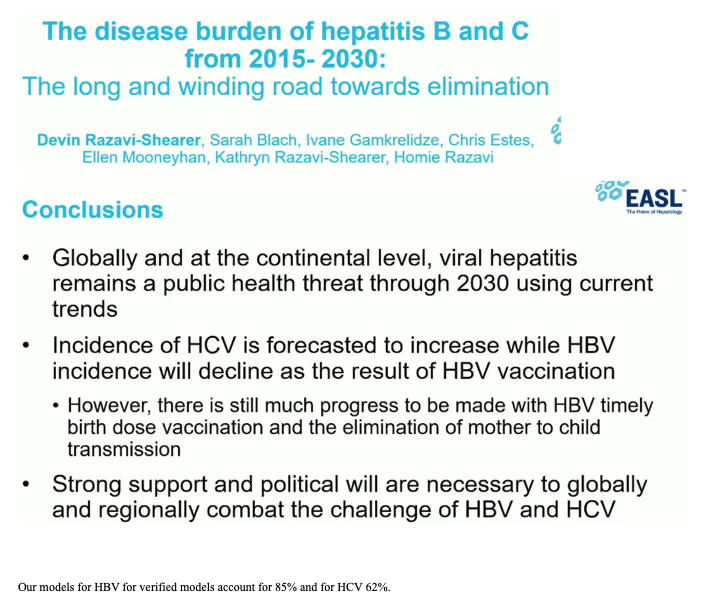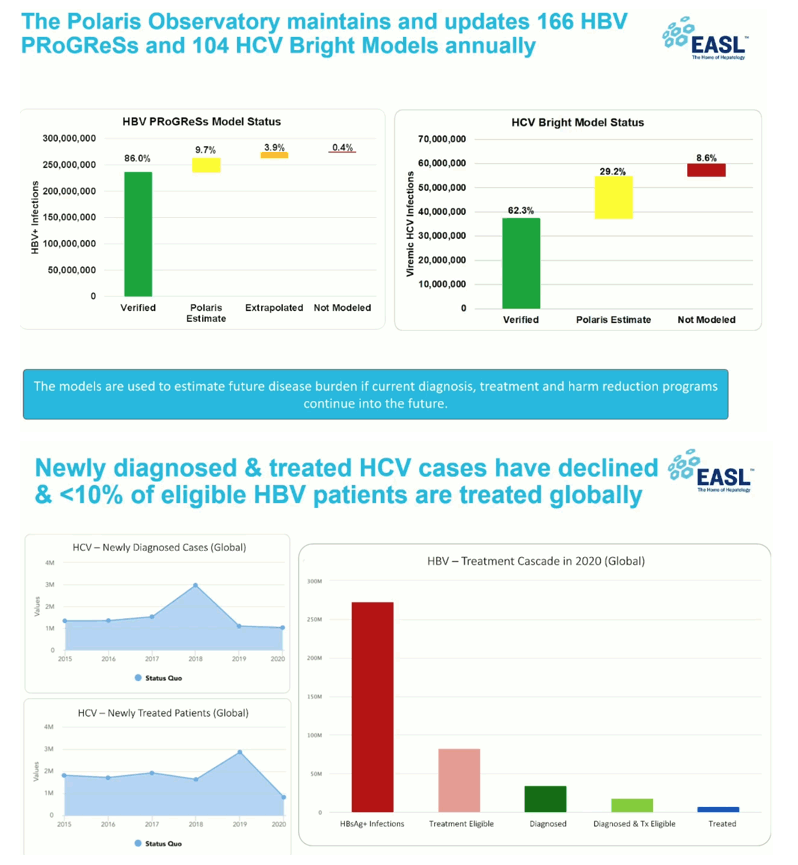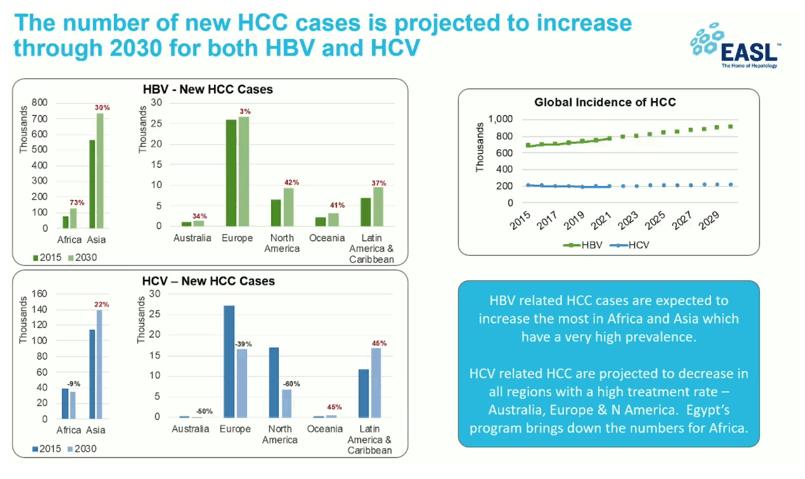 |
 |
 |
| |
The disease burden of hepatitis B and hepatitis C from 2015 to 2030: the long and winding road
New HBV and HCV Projected to Decline Thru 2030, But New HCC Cases Will Rise for both HCV & HBV, HBV liver related deaths expected to increase by 30%
|
| |
| |
EASL International Liver Congress 2022, London, June 22-26, 2022
Mark Mascolini
Separate modeling studies of chronic HBV and viremic HCV infection in 166 countries projected that incidence (new diagnoses) of HBV and HCV infection will fall globally through 2030 [1]. But new cases of hepatocellular carcinoma (HCC) related to both HBV and HCV will rise globally over the next decade, the models said.
Researchers from the Center for Disease Analysis Foundation in the United States [2] annually update 166 HBV and 104 HCV Markov models to project changes in rates of those hepatitis epidemics. Using country-specific input, the models estimate future disease burden if current diagnosis, treatment, and harm reduction efforts hold steady into the future. The models used 2015 data as a baseline and looked forward to 2030.
From 2015 through 2020, newly diagnosed and treated HCV cases both jumped globally in 2017-2018, then decreased through 2020 to levels a little lower than 2015. Over the same years, fewer than 10% of eligible people with HBV infection across the world got treated. If current trends hold, prevalent HBV (HBsAg-positive) infections and HCV viremic infections are forecast to decline from 2015 to 2030 in most regions, due to for HBV increased vaccine use and people dying, and for HCV due to good DAA treatments.. In Europe prevalent HBV will drop 25% and HCV 48%. In North America prevalent HCV will fall 48% but HBV will climb 4% through 2030 because of immigration. Predicted falling HCV prevalence in Africa mainly reflects Egypt's strong anti-HCV program, which tend to obscure the results a little. In Oceania HCV infections are expected to increase due to low treatment rates.
New infections with HBV and HCV (incidence) should fall through 2030, if current trends hold. HBV incidence is on track to decline 78% in Europe, 61% in Latin America and the Caribbean, and 55% in North America, partly because of HBV vaccination. Declines in HBV incidence will be slower in Africa and Oceania because of lower access to HBV vaccines.
New HCV infections should drop in most regions studied (for example, 44% in Europe) because of widening HCV therapy and harm reduction programs across Europe, declining nosocomial transmission and great blood control procedures. But the model sees HCV incidence rising 18% in North America through 2030 because we have an ongoing opioid crisis which is resulting in an increase in new infections in the USA which translates into that increase in North America (Jules: I would add new infections in older people persists at similar levels today as in previous years so both are contributing to increased new infections - among young & old).
Numbers of new HCC cases attributable to both HBV and HCV will climb overall through 2030 if current trends hold. The speaker said Homie Razavi was quoted as saying that the risk of developing HCC for people with HCV or HBV is actually the same as the risk for developing lung cancer for a person smoking a pack of cigarettes a day. "The risk for HCC is really huge and its unreported and underdiscussed in the community". But most of that increase will come in Asia, Africa, and Latin America and the Caribbean. HCV-related HCC cases will drop in Europe, North America, and Australia because of widespread HCV therapy on those continents. HBV-related HCC cases are expected to increase in all continents. HCV HCC-related cases are declining in some continents where we have high treatment rates - Europe, North America for example - but in many other parts of the world its expected to increase -
Modeling projects that HBV liver-related deaths will jump by 30% through 2030, rising in every region unless diagnosis and treatment increase substantially. But HCV liver-related deaths should decline by 5% globally "BUT not by a whole lot", including falls of 75% in North America, 49% in Europe, and 47% in Australia. In contrast, HCV liver-related deaths are on track to balloon 45% in Latin America and the Caribbean. If you take Egypt out of the equation you would see an increase in Africa in HCV HCC-related deaths as opposed to the 3% decrease you see in graph below.
Much work remains in preventing and treating HBV and HCV infection globally, Center for Disease Analysis researchers said, despite certain promising trends with both infections. For example, they noted, elimination of vertical HBV transmission and timely HBV vaccination at birth remain priorities. "Strong support and political will," they stressed, "are necessary to globally and regionally combat the challenge of HBV and HCV."
EASL: Evaluation of Global Progress towards HBV and HCV elimination - off track - (06/23/22)
References
1. Razavi-Shearer D, Blach S, Gamkrelidze I, et al. The disease burden of hepatitis B and hepatitis C from 2015 to 2030: the long and winding road. EASL International Liver Congress 2022, London, June 22-26, 2022. Abstract OS050.
2. Center for Disease Analysis Foundation. https://www.devex.com/organizations/center-for-disease-analysis-foundation-cdaf-132936




HBV - "Unfortunately very few countries are treating that many people, and the stringent eligibility guidelines add to this problem. The current treatments are quite effective, they are just being severely underutilized." what are stringency of the guidelines? and why? I dont understand since HBV treatment (TDF or TAF) are ubiquitous & I would think at the point inexpensive, is it that there is no organization around providing treatment?
The current guidelines set forth by the major liver organizations (including AASLD and EASL) are quite complex. They are made by hepatologists and gastroenterologists to essentially only treat people that you are almost certain would progress to later stages of disease. However, this can mean waiting until people can progress to say cirrhosis before they are eligible for treatment. The result of the guidelines is that 1) they are far too complicated for primary care physicians or nurses to implement and 2) Often people are not treated until they are already quite sick. It is impossible to implement a national elimination strategy without the ability for PCPs to treat at least the non-advanced cases. TDF and TAF are widely available and in most countries and are quite cheap. While sometimes people bring up concerns around safety the argument has always been that the same drugs are being used in people who do not have a disease but are at risk of developing a disease (PrEP) so why would you not treat people that are known to have a disease and among whom you would be able to greatly reduce if not eliminate the probability of them progressing to later stages. Unfortunately there is not a lot of organization around providing treatment and in many countries the onus of seeking out and receiving treatment is on the patients themselves. In many countries it appears that they are more interested having a vaccine program and waiting for the problem to eventually go way, instead of treating the "problem", the people already infected whose lives, and families' lives, are directly impacted by this preventable and highly treatable disease.

|
| |
|
 |
 |
|
|